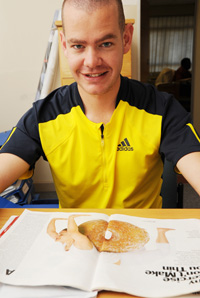The hidden side of the Olympic Games
06 August 2012 Dr Ross Tucker
Dr Ross Tucker
Don't expect a tsunami of swimming records (a lá Beijing 2008) in London, cautioned a UCT exercise physiology expert, just hours before the Olympic torch was lit (and before Team South Africa had racked up an unexpected three golds for swimming and rowing, at the time of going to press.)
Since suits such as swimming attire manufacturer Speedo's LZR Racer, the costume that streamlined the path for 94 of the 96 swimming medals to be won in 2008, have been banned, UCT's Dr Ross Tucker said he had expected a significant drop in performance in the pool at the London 2012 Summer Olympics.
A packed audience listened attentively as Tucker, of the UCT/MRC Research Unit for Exercise Science and Sports Medicine (ESSM), shared insider insights into hidden issues that have had a profound impact on the nature of the historical games.
Despite revised swimming attire regulations, expect similar debates to follow the release of Nike's new TurboSpeed outfit for track sprinters, which Nike claims to be able to shave up to 0.23 seconds off a 100m sprint, said Tucker.
Historically, though, doping has proved a "bigger problem" than clothing in terms of competitive imbalance, Tucker explained. Typically, athletes would cheat either by consuming illegal hormones and other prohibited substances, or by artificially manipulating oxygen levels in their blood.
However, Tucker's message of "qualified hope" showed that, thanks to significant advances in anti-doping controls, the tide is steadily turning in favour of clean sport.
"It's a pharmacological arms race; we were losing it before, but now we are winning," he reported happily.
A particularly touchy issue for South African sports fans has been the seemingly unending furore around whether double-amputee sprinter Oscar Pistorius's carbon-fibre prosthetic legs give him an unfair advantage over his able-bodied rivals.
Tucker revealed research that showed that Pistorius's Flex-Foot Cheetah blades do in fact give Pistorius a significant advantage over his naturally-limbed rivals, both in terms of energy expenditure and in the amount of force required to propel the athlete across the track.
He also cast doubt on the evidence given in support of overturning Pistorius's 2008 ban from able-bodied competition.
 This work is licensed under a Creative Commons Attribution-NoDerivatives 4.0 International License.
This work is licensed under a Creative Commons Attribution-NoDerivatives 4.0 International License.
Please view the republishing articles page for more information.










